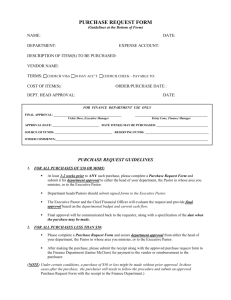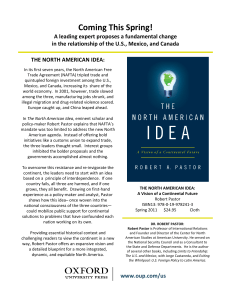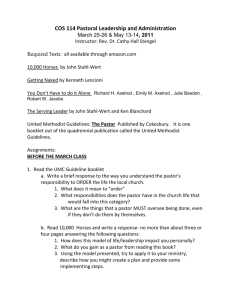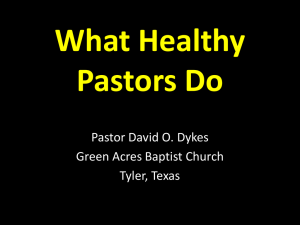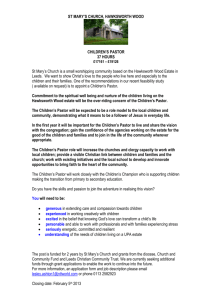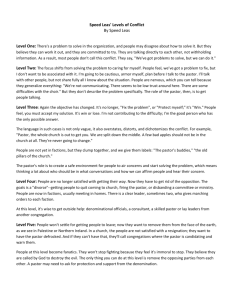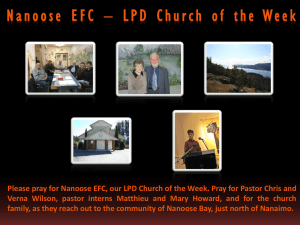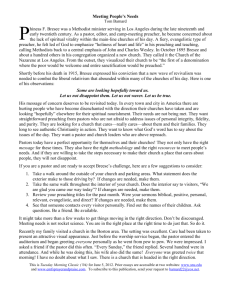Rev. Dixon Worlanyo Pomeyi
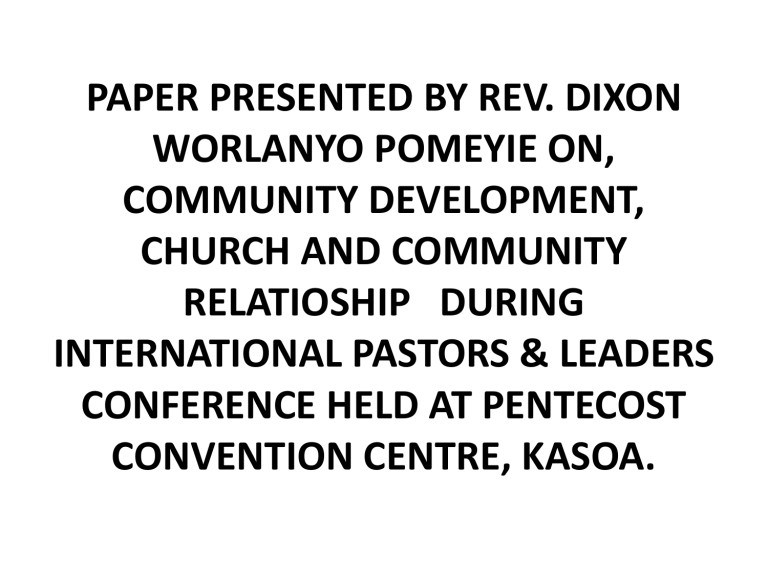
PAPER PRESENTED BY REV. DIXON
WORLANYO POMEYIE ON,
COMMUNITY DEVELOPMENT,
CHURCH AND COMMUNITY
RELATIOSHIP DURING
INTERNATIONAL PASTORS & LEADERS
CONFERENCE HELD AT PENTECOST
CONVENTION CENTRE, KASOA.
Background
• Every church or organization lives within a certain community therefore the church and the community is interdependent. Whatever happened to the church affect the community and vice versa? Therefore there is the need for peaceful co-existence of the two institutions. In community development, both the church and its leaders and also the community and its leaders are considered as stakeholder in the development process therefore for this to happen, there must be a cordial relationship between them. In every organization be it social, religious, corporate etc, there are people in those organizations who drives it in order to achieve the objective of such organization.
Cont.
• Therefore there is the need for such people to build a relationship with one another for the growth of the institution. The Pastor and the church are seen as both the employer on one part and employee on the other hand. The community and its leaders are also seen in the same context as the church. Therefore there is the need to build good and sustainable relationship among these stakeholders of the companies called the church and the community.
Definition
• Human Relations refers to the study of interactions amongst people who have to live and or work together in order to achieve a set goal (Lamptey, 2012).
• According to Armstrong (2010) it deals with the procedural and relational elements of behavior in church organizations.
Cont.
• Mathias and Jackson (2012) noted that it is concerned with understanding of the forces that help shape human interactions at both interpersonal and group levels. Therefore in my opinion, human relations in community development refers to the interaction that exist between one or more stakeholders who come together to work in order to achieve a well defined objective in the development process of their community.
Why the church should build good relationship in the community
• Security & Existence: The community
(members) is the employer without the existence of the community, there will not be a church therefore there is the need for good and sustainable relationship to exist for the existence of the community so that the church will remain in existence.
Cont.
• Strategy Execution: every church in one way or the other has a strategy or goal to achieve in any community that it find itself. The only way to achieve those strategy and objective is to build a good and healthy relationship with the membership and the leaders of the community for you to get 100% support from them.
Cont.
• Members Commitment and Motivation:
Good relationship promotes commitment from the community towards the church and motivates them to do more for the growth of the church which goes a long way to contribute to the success of the pastor.
Therefore community needs to be motivated by the church at times send congratulatory message to the opinion leaders for any achievement in the community.
Cont.
• Place of fellowship and spiritual renewal:
Members of the community believe and see the church as the only place that their spirit can be renewed when they are down in spirit and also having fellowship with one another lift stress and burden on them therefore it is imperative on the side of the church to create a healthy relationship within itself and the community
Forms of Relationship at Church
•
•
•
•
•
•
•
•
•
•
•
•
•
•
• Positive
The church (Pastor) to the community
Community to the Church (Pastor)
Negative
Levels of Relationships
• Hierarchical Relationships: This defines status of a relationship that the individual will exhibit. The status of the person on the organizational chart will determine how the person relates with others. E.g. Some Pastors or Opinion leaders might find it difficult to relate with ordinary members of the church and the community. It is a plus to our bishop.
Cont.
• Members (Peer) Relationships: members with the same skill, professions, inter-dependence and mutual respect might build a relationship for themselves. E.g. someone in the church choir in one local assembly will have a strong relationship with another member of choir in another than women ministry.
Cont.
• Church/Community Relationships: this is where we build a relationship with through the standard doctrine of the church and norms of the community. Using book of discipline to buttress your point for instance the powers of the pastorin-charge concept. Again ban on drumming in the community. Though the standard procedures are there as a voluntary institution, we must not lose the sight of the fact that there are times those standards might not be applicable. Therefore we need to look at the situation and use the best method in build that relationship.
Cont.
• Representation Relationships: This is where relationships are built simply because the individuals are representing various groups at a particular point in time. For example leaders of the church attending meetings with other stakeholders in the community.
Types of Relationships
• Intra-Personal Relationship: This is where the individual relate to oneself. The both the church and the community must relate to itself. This is done through thinking, meditation etc. Both the pastor and the members must have this type of relationship to the growth of the church. Likewise the community. This is the time new ideas and thought will emerge when it is properly conducted.
Cont.
• Inter-Personal Relationship: This is the relationship between members of a church and the community members. Leaders must create a conducive environment for this to take off. There are times members will report issues to their leaders about certain happenings among members. The leaders should be circumspect not to take side and mud the relationship between the members.
Cont.
• Inter-group Relationship: This is a relationship that exists between various groups in the community. Individuals and their leaders in different groups must interact with each other. For instance, members of the
AME church must relate well with people from the Muslim community.
Cont.
• Social Relationship: This is a relationship which is build due to social bond between individuals in the church and the community. Members build relationship because they are from the same ethnic background, from the same family or lineage. This is good but should not be encouraged so much so that it will not lead to setting of classism and ethnocentrism in the community which might affect the unity of the church and the community.
Cont.
• Exploitative Relationship: This is a relationship that exists where one person that is the stronger person build a relationship with another person who is “weak” and take advantage of the situation due to the benefit that the person will enjoy. It is always in the form of harassment and it is not a healthy relationship. Pastor and church leaders and also community leaders must not be found in building such a relationship in the community because it destroys the growth of the community when it is exposed. .
What ‘Human Relations’ is not
• The study of Human Relation in Church
Administration is expected to facilitate better or improved relations in the church. HR in the church however is not aiming at creating a perfect a homogeneous environment, eliminating disagreement of divergent views, making everyone ‘nice-all-the –time’
Aim
• Aim is to ensure that church relations and interactions are based on sound principles, philosophies and policies.
• People must have rewarding interactions
• The strategic and task imperatives are not compromised by poor behaviours and relations
• It is evident that the relationship between the Pastor and the church members is to be a mutual and reciprocal
• Both the pastor and the members must appreciate the impacts of their: behaviours, Emotional responses, interactional dispositions
There are certain variables which influence of affect HRC (Use these variables to build a good relationship in the church)
• Individual Variables: these include personality of the individual, perception attitude, value etc.
• Contextual Variables: these include the culture of the church, the climate and the philosophy of the church and the leader of the church.
• Communication Variables: these include mode of communication, channel of communication and the level of the persons understanding.
THEORIES
• Social Exchange Theory: This theory believes that it is the idea that people evaluate their relationships in terms of cost and rewards. This refers to a situation where the two parties involved in the relationship benefit from each other. If the cost of a relationship outweighs the rewards the relationship will be terminated. The cost is the elements in the relationship that have negative value to a person. The reward on the other hand is those elements that have positive value to a person.
Cont.
• Economic Theory: This is a situation where in the relationship whatever one does should pay off. There should be a minimum positive level at the point the relationship can be sustained

